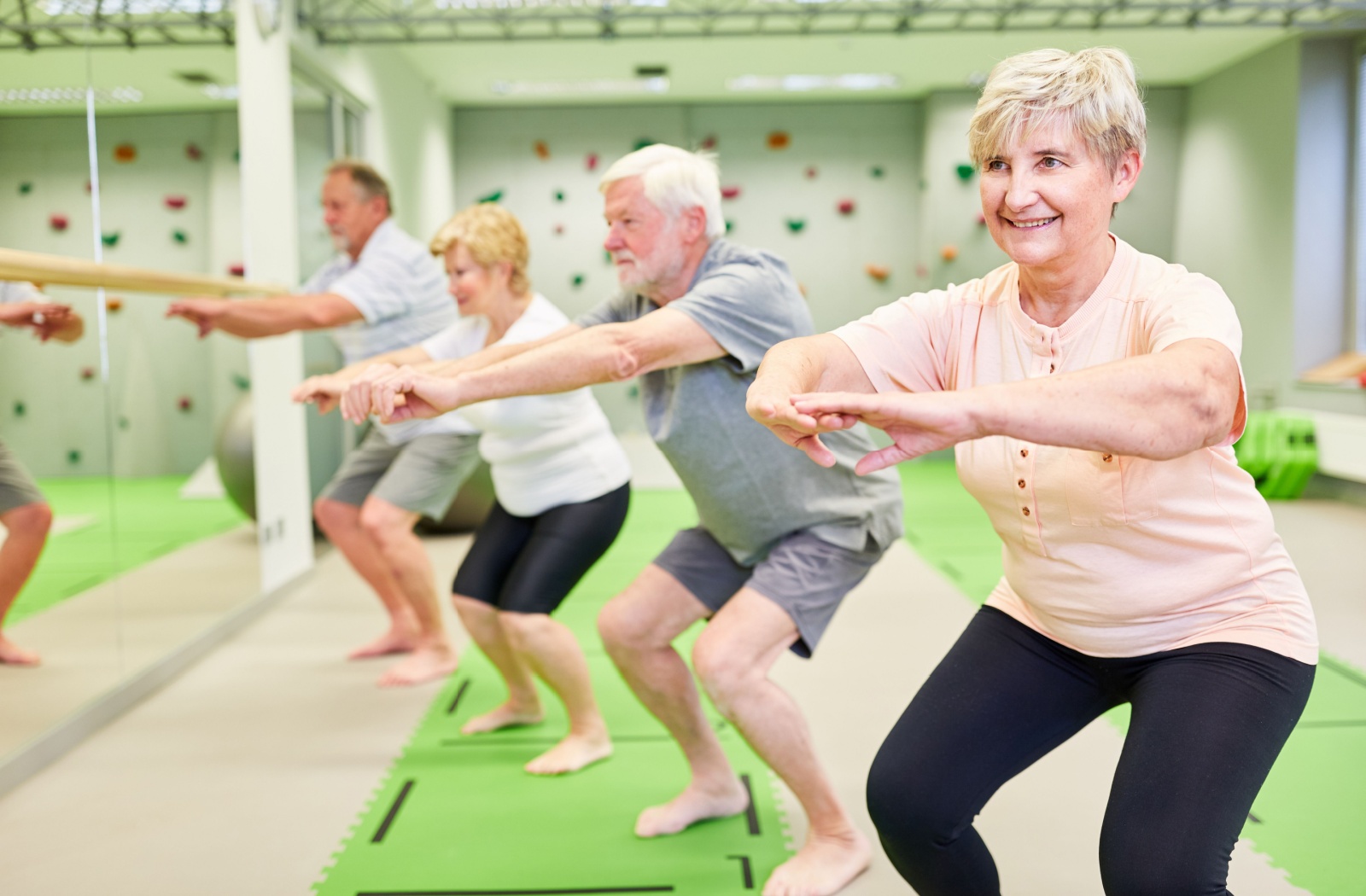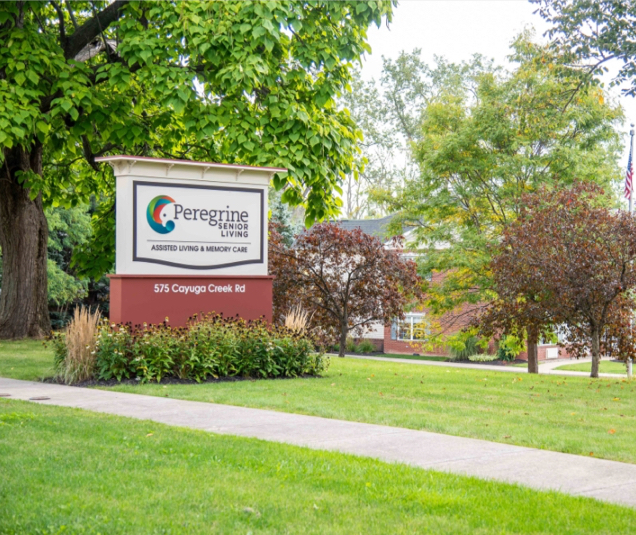Your knee health and strength can be key to preserving mobility, balance, and independence as you age. Whether gardening, walking to the dining room, or getting out of a chair, your knees support nearly every daily activity.
Unfortunately, age-related muscle loss, arthritis, and reduced physical activity can weaken the muscles around the knees, leading to discomfort, trouble with activities of daily living, instability, or even falls.
Targeted, low-impact exercises such as seated leg raises, wall slides, and standing knee bends can help improve knee strength, stability, and flexibility.
These movements are safe for most older adults and can be done at home or in an assisted living setting with little or no equipment.
Why Knee Strength Matters for Seniors
Knee strength plays a critical role in overall mobility and quality of life. As we age, joints become stiffer, muscles weaken, and recovery from falls takes longer—making preventative care more important than ever.
Preventing Falls & Injury
Strong knees improve balance and coordination, reducing the risk of falls—a major concern for many older adults. Exercises that strengthen the quadriceps, hamstrings, and calves help enhance your ability to recover from missteps.
Supporting Joint Health
Muscles act as natural shock absorbers. When they’re strong, they reduce pressure on the knee joint, helping to manage conditions like osteoarthritis and preventing joint degeneration.
Encouraging Independence
Maintaining your knee strength means improved ease with everyday tasks like standing up, walking, climbing stairs, and getting in or out of bed—allowing seniors to stay active and self-sufficient longer.
Getting Started with Knee Exercises
Before starting a new exercise routine, you should understand your body’s limitations and take proper precautions. Knee exercises should be done slowly and carefully, especially if you’re managing existing pain or stiffness.
Safety Tips for Seniors
Always consult your doctor or physical therapist before starting a new fitness plan. Once cleared, follow these basic safety tips:
- Begin with 5–10 minutes of gentle warm-up, like marching in place
- Use a sturdy chair or wall for balance support
- Perform exercises slowly, with control
- Stop immediately if you feel pain (mild soreness is okay)
- Breathe steadily throughout the movement
You can build strength without unnecessary strain by easing into a routine and listening to your body.
Knee Strengthening Exercises for Seniors
These exercises are low-impact, joint-friendly, and can be done with minimal equipment. Most can be performed seated or standing, depending on your comfort and ability.
Seated Leg Raises
Seated leg raises can target the quadriceps, which help stabilize the knees.
How to do it:
- Sit upright in a sturdy chair with both feet flat on the floor.
- Slowly extend one leg straight in front of you, keeping your foot flexed.
- Hold for 3–5 seconds, then slowly lower your foot.
- Repeat 10–15 times per leg.
Standing Knee Bends
Strengthens hamstrings and improves flexibility behind the knee.
How to do it:
- Stand behind a chair, holding the back for balance.
- Slowly bend one knee, bringing your heel toward your buttocks.
- Hold for a few seconds, then lower your foot.
- Repeat 10–15 times per leg.
Wall Slides (Modified Wall Sits)
Wall exercises activate the thigh and glute muscles, supporting knee function.
How to do it:
- Stand with your back against a wall and your feet shoulder-width apart.
- Slowly slide down the wall just a few inches—no deeper than a shallow squat.
- Hold for 5–10 seconds, then slide back up.
- Repeat 5–10 times.
Only go as low as is comfortable and safe for your knees.
Heel & Toe Raises
Heel (calf) and toe raises help strengthen the calves and improve balance and ankle stability, indirectly supporting the knees.
How to do it:
- Stand tall behind a chair or at a counter.
- Raise your heels, standing on your toes; hold for 2–3 seconds.
- Lower your heels and raise your toes, rocking back gently.
- Repeat 10–15 times.
Step-Ups
Step-ups mimic a real-life motion (climbing stairs) while building knee strength and cardiovascular endurance.
How to do it:
- Use a low step or stair and hold a railing if needed.
- Step up with your right foot, then bring your left foot to meet it.
- Step back down with the right foot, then left.
- Repeat 10–12 times, switching lead legs.

Don’t Forget to Stretch
Stretching helps maintain joint flexibility and prevents tight muscles from pulling on the knees. Pair the following stretches with your strengthening routine for best results.
Seated Hamstring Stretch
Hamstring stretches can help relieve back pain, improve posture, and prevent soreness or injury.
- Sit on the edge of a chair and extend one leg forward, heel on the floor.
- Keep your back straight and gently lean forward from your hips.
- Hold for 15–30 seconds, then switch legs.
Standing Calf Stretch
Calf stretches help prevent injuries to your Achilles tendon.
- Stand facing a wall with your hands resting on it for balance.
- Step one foot back and press the heel into the floor.
- Hold for 20–30 seconds, then switch sides.
Stretching should feel good—never painful. Breathe deeply and relax into each stretch.
Making Exercise a Habit
Consistency is key. Try incorporating these exercises into your routine 3–4 times weekly to notice improvements in strength, comfort, and mobility. You don’t need a gym or fancy equipment—just a safe, quiet space and a few minutes each day.
Tips to Keep Seniors Motivated
Staying active doesn’t require high-intensity workouts—gentle, intentional movement goes a long way in supporting your knees and overall wellness. You can help older adults and your loved ones stay motivated by:
- Pairing exercises with daily habits (like leg raises during TV time)
- Keeping a simple progress journal or checklist
- Inviting a friend or family member or joining a group class for accountability
- Celebrating small wins like improved balance or less joint stiffness
When to Seek Professional Support
Stop and consult a healthcare provider if you experience swelling, sharp pain, or difficulty performing these exercises. Physical therapists can offer modified movements tailored to your needs and guide you toward safe progress.
Pain that lingers or worsens isn’t normal—early intervention helps prevent more serious issues.
Supporting Stronger Steps at Peregrine Senior Living
Knee strength is the foundation for safe, confident movement at every age. With just a few simple, consistent exercises, seniors can improve balance, reduce joint pain, and feel more capable in their daily lives.
At Peregrine Senior Living in Cheektowaga, we support residents in staying active through accessible wellness programs, personalized guidance, and a welcoming environment that prioritizes our residents’ health and independence.
Whether your loved one is ready to join a group exercise class or learn a new stretch in the garden, we’re here to help every resident take strong, supported steps forward.
Schedule your tour today to come see our community for yourself.












🎄 The holidays are in full swing!
We celebrated with our families two weeks ago, and it was so much fun. The evening was filled with lots of great food, wonderful holiday music, and cherished time spent together. Thank you to everyone who joined us and helped make the celebration so special! ... See MoreSee Less
0 CommentsComment on Facebook
Yesterday, we had the pleasure of welcoming Maryvale High School to our community for a special performance. Their singing and music were beautiful, and they truly brightened our day. We loved every minute of it and are so thankful for their visit! ... See MoreSee Less
1 CommentsComment on Facebook
Thank you to Walmart for choosing our community to deliver gifts to our residents and spread so much Christmas cheer. We are incredibly appreciative of your generosity and kindness! ... See MoreSee Less
3 CommentsComment on Facebook
As the candles of Hanukkah shine brightly, we’re reminded of the strength of faith, the warmth of family, and the enduring power of hope.
May each night bring moments of reflection, joy, and togetherness for all who celebrate. 🕎
From our Peregrine family to yours—Happy Hanukkah!
peregrinecheektowaga.com/ ... See MoreSee Less
0 CommentsComment on Facebook
Thank you to Tyshawn from the Wounded Warriors Project for visiting our community and giving such a heartfelt presentation. We truly appreciate you taking the time to share your message with our residents. ... See MoreSee Less
1 CommentsComment on Facebook
Pictures from our last craft show. The vendors are so creative! ... See MoreSee Less
1 CommentsComment on Facebook
Every person carries a lifetime of memories, passions, and dreams. Those stories deserve to be celebrated.
Through The Peregrine Way, we honor each resident’s individuality by creating meaningful experiences that nurture mind, body, and spirit. Whether it’s rekindling a lifelong hobby, connecting through music, or simply sharing conversation over coffee, every day is a chance to live with joy and purpose.
We don’t just care for residents, we walk alongside them, helping every story continue with dignity, laughter, and love. 💗
peregrinecheektowaga.com/ ... See MoreSee Less
0 CommentsComment on Facebook